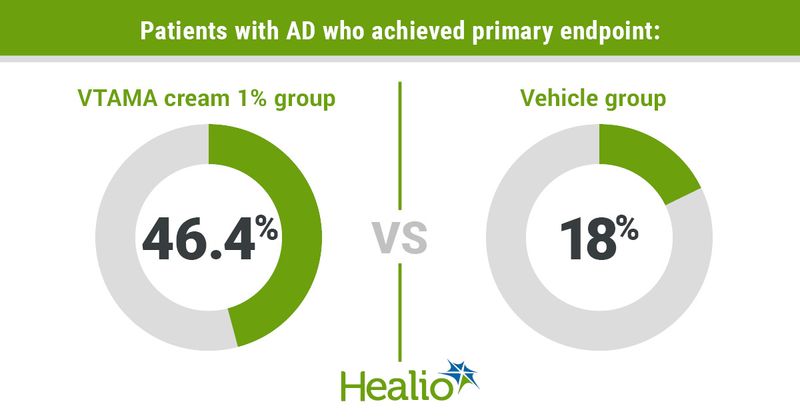Vtama cream exhibits ‘remarkable results’ in atopic dermatitis treatment
Click Here to Manage Email Alerts
Key takeaways:
- 46.4% of children and adults receiving Vtama achieved validated IGA for atopic dermatitis response of clear or almost clear.
- 92.4% of ADORING 2 subjects elected to enroll in ADORING 3, a 48-week, open-label, extension study.
Results showed that Vtama cream 1% was safe, effective and well tolerated in a phase 3 study evaluating the cream in adults and children aged as young as 2 years with atopic dermatitis, Dermavant Sciences announced in a press release.
“Ninety percent of the medicines that are addressing eczema in the United States are topical steroids,” Todd Zavodnick, CEO at Dermavant Sciences, told Healio. “We saw remarkable results in this study and are very excited that families may soon have a nonsteroidal option.”

Vtama (tapinarof) cream 1%, a nonsteroidal, aryl hydrocarbon receptor agonist, was approved by the FDA for adults with plaque psoriasis in May 2022. Since then, the drug has been evaluated for the treatment of AD in children and adults in two identical phase 3 studies, ADORING 1 and ADORING 2.

In ADORING 2, a total of 406 adults and children aged 2 years and older with AD received identical doses of Vtama cream 1% or vehicle once daily for 8 weeks.
Results showed that 46.4% of patients receiving Vtama cream achieved the primary endpoint of a clear or almost clear validated IGA for atopic dermatitis response with at least a 2-grade improvement from baseline by week 8 compared with only 18% receiving vehicle (P < .0001).
Secondary endpoints were also achieved, with 59.1% of participants treated with VTAMA reaching EASI 75 compared with 21.2% of vehicle-treated patients (P < .0001).
Results also showed an improved quality of life, with 52.8% of patients treated with the study drug aged 12 years and older seeing a 4-point reduction on the peak pruritus numerical rating scale compared with 24.1% of vehicle (P = .0015).
The study reported no safety or tolerability signals among patients, with only 1.5% discontinuing due to treatment-related adverse events compared with 3% of vehicle-treated patients.
At the end of the trial, 92.4% of participants elected to continue treatment into Dermavant’s long-term safety study, ADORING 3.
“This blew me away,” Zavodnick added. “In dermatology, usually rollover rates are somewhere between 50% to 60%. But when you see 92.4%, that tells you that you’re getting remarkable efficacy, itch control and a safe and tolerable agent.”
These results, along with ADORING 1 results expected in May 2023, will support Dermavant’s supplemental new drug application filing in early 2024.
Over the last 9 months, Dermavant has received 110,000 prescriptions for Vtama cream, marking one of the fastest launches in topical dermatology, according to Zavodnick.
“We are bringing truly novel medicines,” Zavodnick said. “I believe we are going to see Vtama come in and have the opportunity to transform the market on the topical side.”
